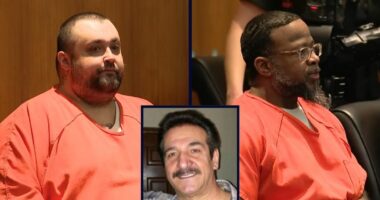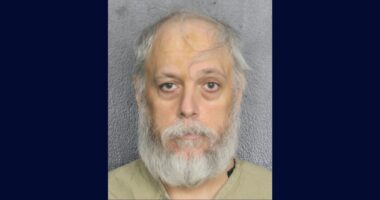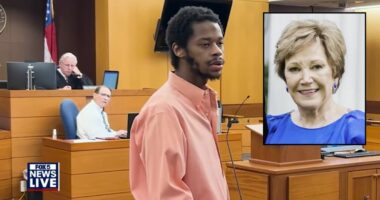Share this @internewscast.com
The trial of former Minneapolis police officer Derek Chauvin moved methodically through its second week of testimony, giving the jury a more complete picture of the forces that shaped Chauvin’s deadly interaction with George Floyd on May 25, 2020.
Floyd, a Black man, was captured on video that day struggling with a small group of officers for allegedly using a counterfeit $20 bill until Chauvin, a white man, pinned him to the ground by the neck with his knee for more than nine minutes. Floyd appeared to be unconscious for more than four of those minutes. He was then taken to a hospital, where he was pronounced dead.
On Monday morning, jurors heard from the emergency room physician who made the pronouncement, followed by other medical professionals who took the stand to lend their expertise. A steady parade of use of force experts, including Minneapolis police chief Medaria Arradondo, either cast doubt on Chauvin’s chosen method of restraint or denounced it.
In more procedural testimony, lab techs made plain the substances found in the car Floyd was using at the time of his arrest, as well as in the back seat of the police vehicle he was momentarily contained in.
Prosecutors used the second week to build on the often emotional testimony from Week 1, which shone a spotlight on the bystanders who agitated over the officers’ treatment of Floyd.
“It’s been a very strong case on the part of the prosecution,” University of Washington law professor Mary Fan told HuffPost after the second week.
Howard University associate law professor Justin Hansford told HuffPost he was “not really impressed” with the prosecution’s first week, saying that he did not believe the team focused enough on substantive arguments.
“This week, I think the prosecution did much better,” he said.
Chauvin has pleaded not guilty to all three of the homicide-related charges against him. If convicted, he could face 11 to 15 years behind bars.
Here’s what you missed:
Medical professionals agree: George Floyd likely died from asphyxia, or a lack of oxygen.
Some of the most damning testimony this week came from Dr. Martin Tobin, a renowned pulmonologist who has studied how people breathe for more than four decades. Through diagrams, 3D modeling and mathematical calculations, Tobin walked the jury through the way he believed Floyd died, explaining how Floyd’s “prone” position, the placement of his handcuffs, the knee to his neck and knee to his back and left side made breathing difficult and then impossible.
(The prone position, a term used frequently at the trial, refers to when a person is lying on their stomach.)
“It’s like the left side is in a vise,” Tobin testified. “It’s totally been pushed in, squeezed in from each side, from the street at the bottom and from the way that the handcuffs are manipulated.” It was almost as if Floyd’s left lung had been surgically removed, Tobin said, adding, “Not quite, but along those lines.”
In a particularly somber moment on the stand, he showed the jury the precise moment he believed Floyd died.
Importantly, Tobin noted that Floyd succumbing to those forces was not an idiosyncrasy, even though he suffered from heart disease and had fentanyl and methamphetamine in his system when he died.
“A healthy person subjected to what Mr. Floyd was subjected to would have died as a result of what he was subjected to,” Tobin testified.
Dr. Lindsey Thomas, a consulting forensic pathologist, made a similar remark, telling the courtroom, “There’s no evidence to suggest that he would’ve died that night except for the interactions with law enforcement.”
Both Dr. Bradford Langenfeld, the emergency physician who treated Floyd at the Hennepin County Medical Center, and Dr. Andrew Baker, Hennepin County’s chief medical examiner who performed Floyd’s first autopsy, determined that asphyxia was the most likely explanation for his death.
No one disagrees that there were drugs at the scene and in Floyd’s body, or that he had preexisting conditions.
One of the key issues Chauvin’s trial highlights is whether it’s reasonable to expect police to be able to handle people with such conditions ― heart disease or addiction issues, as many people in America have ― without killing them.
“There’s a saying in law that one takes one’s victim as one finds him,” Fan told HuffPost. “If you were to push an elderly person to the ground, and they die, you wouldn’t say, ‘Well, it’s their fault. They’re elderly.’”
“In a way, it’s a distraction issue,” Fan said of Floyd’s health.
The “blue wall” is cracking — or maybe we’re just seeing another side of it.
Arradondo, the Minneapolis police chief, emphasized how Chauvin had “absolutely” violated the department’s policy on use of force on the stand.
“There’s an initial reasonableness in trying to get him under control in the first few seconds, but once there was no longer any resistance, and clearly when Mr. Floyd was no longer responsive, and even motionless, to continue to apply that level of force to a person proned out, handcuffed behind their back, that in no way, shape or form is anything that is by policy,” Arradondo said. “It’s not part of our training, and it is certainly not part of our ethics or values.”

“This is the first time that I’ve seen some cracks in the so-called blue wall of silence, and it gives me some hope,” Boston College of Law professor Robert Bloom told HuffPost.
Prosecutors also called to the stand several other law enforcement professionals who specialize in use of force training.
Chauvin’s colleagues with the Minneapolis Police Department stopped short of directly criticizing his actions, but consistently indicated that use of force is expected to let up once a subject stops resisting. One outside specialist, the Los Angeles Police Department’s Jody Stiger, said he believed Chauvin wrongly used deadly force against Floyd.
“The police did seem to try to go out of their way and say that Chauvin used the techniques wrong, or that, you know, he went a little too far,” Hansford said.
On cross-examination, however, law enforcement largely agreed with defense attorney Eric Nelson when he pointed out that officers have to protect themselves from potential threats, as well. One of Nelson’s key objectives is to convince the jury that Chauvin was generally following police training ― that what viewers saw on camera is part of the “awful but lawful” side of police work.
“I think a lot of this country … it’s rare when they actually see people apprehended by police in person,” Hansford said. “I think most of the country may not know that police sit on people often, police put their knees on the back of people often, this is part of the day-to-day police work.”
“Even the police who testified on behalf of the prosecution, they went to great lengths to make the ‘bad apple’ argument,” he continued. “In the process, they’re defending the institution of policing, in terms of the status quo and how it should stay the same.”
“Now, the rest of the world is probably horrified” by what they have seen on viral videos of Floyd’s arrest, Hansford went on. “So in a lot of ways, if the defense is persuasive, that’s a greater indictment of the police than if, you know, Chauvin was convicted.”
Regardless, Chauvin’s defense still has a ways to go.
Next week, the defense is expected to start calling witnesses of their own ― offering Chauvin’s attorneys a necessary chance to strengthen their arguments.
Throughout the trial, Nelson has tried to paint the crowd that gathered around Floyd and the arresting officers as a distraction at best, or a threat at worst. He also aims to prove that Floyd’s preexisting health conditions ― and his choice to use drugs ― had a more significant effect on the outcome of his arrest than Chauvin’s actions.
Yet at many points during his cross-examination this week, Nelson received pushback over the way he characterized some of the medical elements of Floyd’s death, casting doubt on his narrative before the jury.
His depiction of the crowd may also raise eyebrows in the coming days.
“Their argument is that there was a rowdy crowd around, and that he lost track of what he was doing because of the rowdy crowd,” Bloom said. “But then you see this 9-year-old kid. A 17-year-old. You see this poor guy that was in tears having seen this, you know? They didn’t look particularly rowdy to me.”
“Its going to be hard to argue that it was not the knee to the neck that was the major contributing cause,” Hansford told HuffPost.
The trial resumes Monday at about 10 a.m. Eastern time.
Calling all HuffPost superfans!
Sign up for membership to become a founding member and help shape HuffPost’s next chapter
Source: huffpost

















